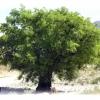The Sundarbans archipelago in the Bay of Bengal is the most extensive contiguous mangrove forest on earth. It lies on the world's largest delta, formed by the rivers Ganga, Brahmaputra and Meghna, with several hundred islands spreading across 9,630 sq km in India and 16,370 sq km in Bangladesh. The name comes from the dominant mangrove species, Heritiera fomes, locally known as the Sundari tree.
A UNESCO World Heritage Site, Sundarbans is home to a wide range of animals, aquatic mammals, birds, reptiles and insects, like the Royal Bengal Tiger, golden jackal, saltwater crocodile (the world's largest reptile), chital (spotted deer), Indian pangolin, monocled cobra, Russell’s Viper, Indian rat snake, otter, kestrel, shikra, white-bellied sea eagle, nlack-headed ibis, darter, brown-winged kingfisher, ghost crab, fiddler crab, mudskipper, common clubtail dragonfly, pygmy dartlet damselfly, yamfly and Indian honey bee.
Fishing is the primary occupation, others being rice cultivation and bee keeping. Illegal fishing, crab hunting and prawn seed collecting inside the core forest area are major ecological concerns.












